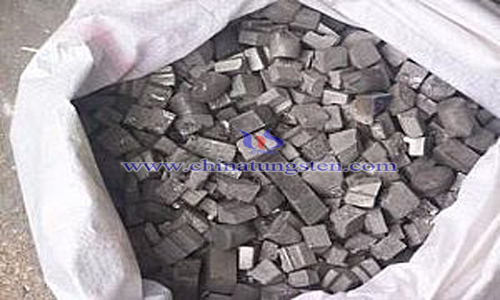Strategy for Separation and Recycle of Silver Tungsten Waste
- Details
- Category: Tungsten Information
- Published on Saturday, 15 September 2018 23:43
Silver-tungsten materials are generally used in low-voltage plastic case circuit breakers, universal circuit breakers and protective switches, as moving contacts. Silver-tungsten materials are usually fabricated by infiltration process in powder metallurgy, such as the steps of making AgW50 materials: (1) silver and tungsten powder are mixed into AgW70 powder according to 3:7; (2) pressing AgW70 porous skeleton; (3) adding silver plate to obtain dense AgW50 materials by high temperature infiltration, and the silver content of waste materials produced in the production process is generally between 20-50%. Separation and recycling are needed.

At present, the traditional method of recovering silver and tungsten wastes is mainly nitric acid dissolution, and then hydrazine hydrate reduction. As tungsten does not react with nitric acid in acid dissolution, the recovery rate is low, tungsten is basically lost and polluted. Therefore, it is urgent to find a perfect solution to the waste recovery problem.
Recently, some scholars have solved this problem by liquid-phase sintering. The working principle is to sinter silver-tungsten waste into a sintering boat in liquid phase, sinter into a plate-like silver-tungsten plate, and then crush into silver powder and tungsten powder. The working process is as follows.
1.24 kg AgW80 scrap was loaded into graphite boat in 4 furnaces and sintered at 1200 ℃ for 30 minutes to obtain Ag-W alloy plate.
2.Using silver-tungsten plate as anode, titanium plate as cathode, 15wt% silver nitrate as electrolyte, adjusting PH value by nitric acid to 1.5, electrolysis was carried out under the condition of cathode current density 250A/m2 and cell voltage 3V. After washing, the silver content was 99.65% and the recovery rate was 97.9%.
1.24 kg AgW80 scrap was loaded into graphite boat in 4 furnaces and sintered at 1200 ℃ for 30 minutes to obtain Ag-W alloy plate.
2.Using silver-tungsten plate as anode, titanium plate as cathode, 15wt% silver nitrate as electrolyte, adjusting PH value by nitric acid to 1.5, electrolysis was carried out under the condition of cathode current density 250A/m2 and cell voltage 3V. After washing, the silver content was 99.65% and the recovery rate was 97.9%.
3.The tungsten skeleton with silver content of 1.50% was obtained by drying the electrolytic anode slime at 150 ℃ for 2 hours.
4.The crushed silver-containing tungsten powder was dissolved in 40% nitric acid and filtered to get the slurry and filter residue. The slurry was adjusted to pH 8 by ammonia water, then reduced and cleaned with hydrazine hydrate. The silver content was 99.70% and the recovery was 1.48%. The comprehensive recovery of electrolytic silver powder and acid-soluble silver powder was 99.38%.
5.Put the filter residue into oven at 150 ℃ for 2 hours and then transfer it to reducing atmosphere at high temperature. The reduction temperature is 900 C for 5 hours. The tungsten powder is obtained. The tungsten content in the tungsten powder is 99.56% and the recovery rate of tungsten is 99.1%.
6.Mixing the silver powder with tungsten powder in the ratio of 3:7, reclaiming the insufficient part of silver powder with pure silver powder, making AgW70 powder for AgW50 material.
Compared with the traditional process, the new process reduces the process of repeated acid dissolution, only one electrolysis plus one acid dissolution, more thorough separation, less environmental impact, silver and tungsten can reach 99% recovery, can be directly reused.
- Tungsten Manufacturer & Supplier, Chinatungsten Online: www.chinatungsten.com
- Tungsten News & Prices of China Tungsten Industry Association: www.ctia.com.cn
- Molybdenum News & Price: news.molybdenum.com.cn
- Tel.: 86 592 5129696; Fax: 86 592 5129797; Email: sales@chinatungsten.com



 sales@chinatungsten.com
sales@chinatungsten.com